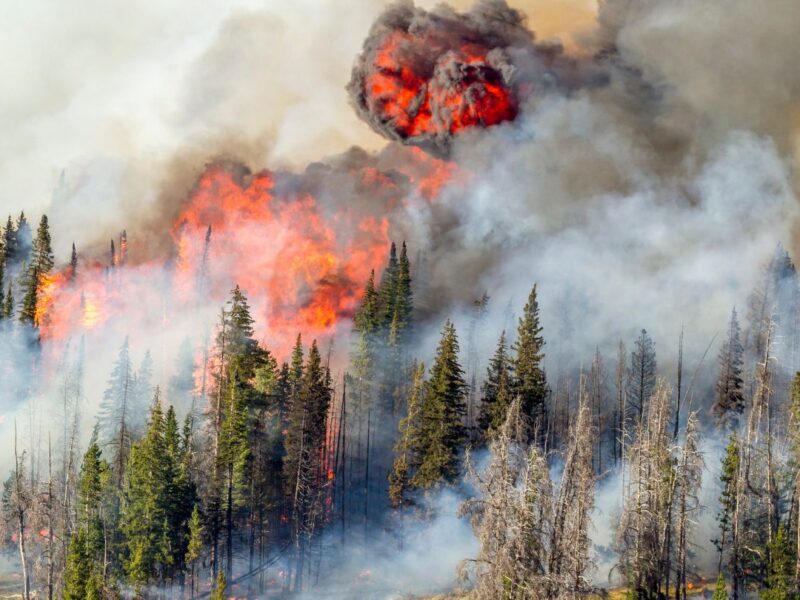Are drones an answer to wolf attacks on livestock?
Over just 20 days in the summer of 2022, there were 11 confirmed depredations by the resident Rogue Pack wolves in Southern Oregon’s Klamath Basin. But gray wolves are listed as federally endangered under the Endangered Species Act (ESA) in two-thirds of Oregon, including the Klamath Basin, making it illegal to kill a wolf—even if it is caught in the act of attacking livestock.
That’s why Dustin Ranglack and his team are evaluating whether drones might be part of the answer. “We are focused on resolving human-wildlife conflicts with predators, so a lot of that is working on developing different conflict prevention tools for stopping predation,” says Ranglack, the predator project leader at Utah Field Station of the U.S. Department of Agriculture’s Animal Plant Health Inspection Service (APHIS) Wildlife Services National Wildlife Research Center.
When wolf-livestock conflict becomes chronic in areas where wolves are federally listed as an endangered species,
producers and wildlife managers have to seek creative solutions.

One of the drones Ranglack’s team used for hazing trials. Photo by Dustin Ranglack/USDA.
Immediately following that heightened depredation event in the summer of 2022, Wildlife Services’ Oregon nonlethal team initiated night watch with a crew on the ground and drones equipped with thermal cameras. When wolves were located, the team hazed them from the ground and with the drone. The cameras allowed Ranglack’s research team to locate the wolves and to evaluate how they responded to the drone. Ranglack explains, “We were looking for a strong negative response to the drone from the wolf.”
On the first encounter between the drone and a wolf, the team attempted to haze the wolf with the drone, but the wolf responded with the classic “downward dog” pose and tail wag of a playful canine. So the team added a speaker to the drone through which they broadcast the pilot’s voice. Further trials showed that the drone equipped with a speaker was highly effective at hazing wolves away from cattle and even for stopping an attack in progress by multiple wolves.
Limitations and drawbacks
While there are limitations to this tool—including battery life, flight time and vegetation cover—Ranglack confirms that “drones can be an effective hazing tool.” During the drone trial period in 2022, just two depredations occurred in 85 nights, equating to nearly a 96% reduction in depredation events. Despite the success, Ranglack laments, This was not cheap.” The 85-day trial came with an estimated cost of more than $130,000, and the drones used by the team cost $18,000 each.
More trials around the West
Clearly, big questions still remain: In what landscapes will the tool work best? Where might it be most cost-effective? “We are looking for people who are interested in using this technology as a hazing tool for wolves, so we can learn when and where this tool is effective and when and where it is not,” Ranglack says.
If you are interested in learning more, please contact Dustin Ranglack at dustin.ranglack@usda.gov.
Watch a video presentation by Ranglack that includes footage of the drone hazing wolves as they attack cattle
Sorry, the comment form is closed at this time.






WILLIAM RAY BECK
it is very unfortunate that the uninformed virtue signaling folks who pushed the artificial introduction of these wolves in 1995 don’t have to live with the consequences of their actions.
maybe they would change their tune?
Save Ag
Gallagher has come out with the E-shepard for cattle that has a GPS corrective collar, and I believe a little solar panel that lasts for years. Could these be adapted to a smaller size and keep wolves on public land or currently ungrazed areas?
Nelson Shirley
I’ve never heard a good response to the problem created by wolf ‘hazing’, which is habituation to human presence and the fact that all you’re doing is hazing wolves onto your neighbors’ livestock. When practitioners comment on the lower depredation rates on their ranch compared to their neighbors, I can’t help but wonder whether they directly contributed to their neighbors’ higher losses. The failure to deliver a penalty to wolves when they attack livestock just makes the problem worse later, and maybe for someone else. The success of every livestock ranch operation in the west is directly tied to the success of your neighbors. Whether you like to admit it or not. Fencing, lost livestock, firefighting, help with spring and fall works, and the financial support of local ranch supply companies are all inextricably tied together. Ranch neighbors can be frustrating at times but none of us are an island.